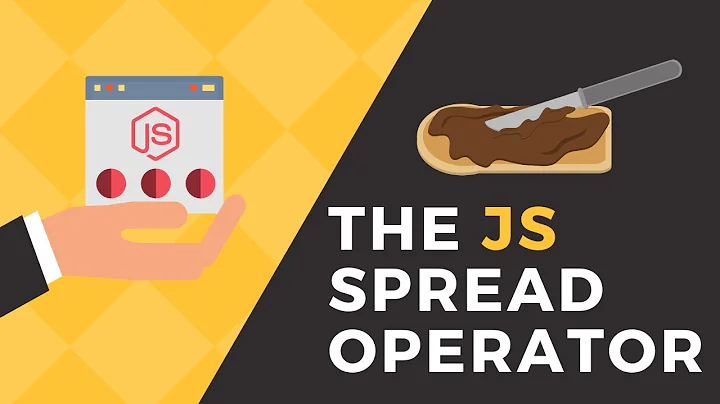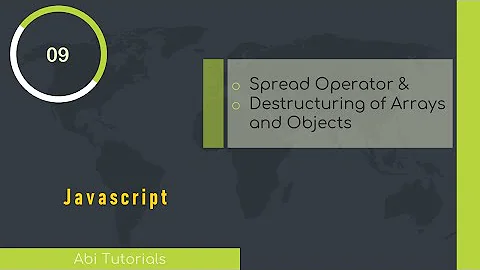spread operator vs array.concat()
Solution 1
Well console.log(['one', 'two', 'three', 'four', 'five']) has the same result as well, so why use either here? :P
In general you would use concat when you have two (or more) arrays from arbitrary sources, and you would use the spread syntax in the array literal if the additional elements that are always part of the array are known before. So if you would have an array literal with concat in your code, just go for spread syntax, and just use concat otherwise:
[...a, ...b] // bad :-(
a.concat(b) // good :-)
[x, y].concat(a) // bad :-(
[x, y, ...a] // good :-)
Also the two alternatives behave quite differently when dealing with non-array values.
Solution 2
concat and spreads are very different when the argument is not an array.
When the argument is not an array, concat adds it as a whole, while ... tries to iterate it and fails if it can't. Consider:
a = [1, 2, 3]
x = 'hello';
console.log(a.concat(x)); // [ 1, 2, 3, 'hello' ]
console.log([...a, ...x]); // [ 1, 2, 3, 'h', 'e', 'l', 'l', 'o' ]
Here, concat treats the string atomically, while ... uses its default iterator, char-by-char.
Another example:
x = 99;
console.log(a.concat(x)); // [1, 2, 3, 99]
console.log([...a, ...x]); // TypeError: x is not iterable
Again, for concat the number is an atom, ... tries to iterate it and fails.
Finally:
function* gen() { yield *'abc' }
console.log(a.concat(gen())); // [ 1, 2, 3, Object [Generator] {} ]
console.log([...a, ...gen()]); // [ 1, 2, 3, 'a', 'b', 'c' ]
concat makes no attempt to iterate the generator and appends it as a whole, while ... nicely fetches all values from it.
To sum it up, when your arguments are possibly non-arrays, the choice between concat and ... depends on whether you want them to be iterated.
The above describes the default behaviour of concat, however, ES6 provides a way to override it with Symbol.isConcatSpreadable. By default, this symbol is true for arrays, and false for everything else. Setting it to true tells concat to iterate the argument, just like ... does:
str = 'hello'
console.log([1,2,3].concat(str)) // [1,2,3, 'hello']
str = new String('hello');
str[Symbol.isConcatSpreadable] = true;
console.log([1,2,3].concat(str)) // [ 1, 2, 3, 'h', 'e', 'l', 'l', 'o' ]
Performance-wise concat is faster, probably because it can benefit from array-specific optimizations, while ... has to conform to the common iteration protocol. Timings:
let big = (new Array(1e5)).fill(99);
let i, x;
console.time('concat-big');
for(i = 0; i < 1e2; i++) x = [].concat(big)
console.timeEnd('concat-big');
console.time('spread-big');
for(i = 0; i < 1e2; i++) x = [...big]
console.timeEnd('spread-big');
let a = (new Array(1e3)).fill(99);
let b = (new Array(1e3)).fill(99);
let c = (new Array(1e3)).fill(99);
let d = (new Array(1e3)).fill(99);
console.time('concat-many');
for(i = 0; i < 1e2; i++) x = [1,2,3].concat(a, b, c, d)
console.timeEnd('concat-many');
console.time('spread-many');
for(i = 0; i < 1e2; i++) x = [1,2,3, ...a, ...b, ...c, ...d]
console.timeEnd('spread-many');Solution 3
I am replying just to the performance question since there are already good answers regarding the scenarios. I wrote a test and executed it on the most recent browsers. Below the results and the code.
/*
* Performance results.
* Browser Spread syntax concat method
* --------------------------------------------------
* Chrome 75 626.43ms 235.13ms
* Firefox 68 928.40ms 821.30ms
* Safari 12 165.44ms 152.04ms
* Edge 18 1784.72ms 703.41ms
* Opera 62 590.10ms 213.45ms
* --------------------------------------------------
*/
Below the code I wrote and used.
const array1 = [];
const array2 = [];
const mergeCount = 50;
let spreadTime = 0;
let concatTime = 0;
// Used to popolate the arrays to merge with 10.000.000 elements.
for (let i = 0; i < 10000000; ++i) {
array1.push(i);
array2.push(i);
}
// The spread syntax performance test.
for (let i = 0; i < mergeCount; ++i) {
const startTime = performance.now();
const array3 = [ ...array1, ...array2 ];
spreadTime += performance.now() - startTime;
}
// The concat performance test.
for (let i = 0; i < mergeCount; ++i) {
const startTime = performance.now();
const array3 = array1.concat(array2);
concatTime += performance.now() - startTime;
}
console.log(spreadTime / mergeCount);
console.log(concatTime / mergeCount);
Solution 4
The one difference I think is valid is that using spread operator for large array size will give you error of Maximum call stack size exceeded which you can avoid using the concat operator.
var someArray = new Array(600000);
var newArray = [];
var tempArray = [];
someArray.fill("foo");
try {
newArray.push(...someArray);
} catch (e) {
console.log("Using spread operator:", e.message)
}
tempArray = newArray.concat(someArray);
console.log("Using concat function:", tempArray.length)Solution 5
Although some of the replies are correct when it comes to performance on big arrays, the performance is quite different when you are dealing with small arrays.
You can check the results for yourself at https://jsperf.com/spread-vs-concat-size-agnostic.
As you can see, spread is 50% faster for smaller arrays, while concat is multiple times faster on large arrays.
Related videos on Youtube
Ramesh Rajendran
Technologies : HTML CSS Asp.Net MVC Web Api C# Angular 1-7 Unit Test (Front End & Back End) I am currently working in L&T . Read my blog C# DotNet Solutions.
Updated on April 12, 2022Comments
-
 Ramesh Rajendran about 2 years
Ramesh Rajendran about 2 yearsWhat is the difference between
spread operatorandarray.concat()let parts = ['four', 'five']; let numbers = ['one', 'two', 'three']; console.log([...numbers, ...parts]);Array.concat()functionlet parts = ['four', 'five']; let numbers = ['one', 'two', 'three']; console.log(numbers.concat(parts));Both results are same. So, what kind of scenarios we want to use them? And which one is best for performance?
-
 Ele about 6 years@gurvinder372 I think the OP knows that.
Ele about 6 years@gurvinder372 I think the OP knows that. -
 Fabien Greard about 6 years
Fabien Greard about 6 years -
 Jota.Toledo about 6 yearsThe example isnt the best as already pointed. Please update
Jota.Toledo about 6 yearsThe example isnt the best as already pointed. Please update -
 Ramesh Rajendran about 6 years@FabienGreard That is nice information.
Ramesh Rajendran about 6 years@FabienGreard That is nice information. -
 Ele about 6 yearsPrimarily opinion-based question!
Ele about 6 yearsPrimarily opinion-based question! -
nicowernli about 6 yearspossible duplicate stackoverflow.com/questions/39716216/…
-
 Ramesh Rajendran about 6 years@nicowernli Am asking about concat() not push().
Ramesh Rajendran about 6 years@nicowernli Am asking about concat() not push(). -
 Suraj Rao about 6 years
Suraj Rao about 6 years -
 Ramesh Rajendran almost 5 years@SurajRao There is no much more information than this below answer
Ramesh Rajendran almost 5 years@SurajRao There is no much more information than this below answer -
 Suraj Rao almost 5 years@RameshRajendran true.. added it as it is related
Suraj Rao almost 5 years@RameshRajendran true.. added it as it is related
-
-
Bergi about 6 yearsThis use of spread syntax (function call) is not what was asked about (array literal).
-
 Ramesh Rajendran about 6 yearsIs it possible to do concat or spread an array in between an another array?
Ramesh Rajendran about 6 yearsIs it possible to do concat or spread an array in between an another array? -
 Ankit Agarwal about 6 yearsI know that, the OP has not
Ankit Agarwal about 6 yearsI know that, the OP has notpushthe element. But we usuallypushthe element in array so I am trying to show the consequences when we will use the push with spread. -
Bergi about 6 years@RameshRajendran In between two other arrays, sure. "In between an other array", not sure what you mean.
-
 Ramesh Rajendran about 6 yearsFor example I can use spread operators in between the array objects.
Ramesh Rajendran about 6 yearsFor example I can use spread operators in between the array objects.['one',...parts, 'two', 'three'];. nowfour and fiveis move to second potion. Is it possible inconcat() -
Bergi about 6 years@RameshRajendran The equivalent to that would be
['one'].concat(parts, ['two', 'three'])(or['one'].concat(parts).concat(['two', 'three'])if you don't want to pass multiple arguments) -
 Luis Villavicencio over 5 yearsYou should clarify that the stack gets used when a function call uses spread inside. However when it is an array literal only and the spread is used, no stack is ever used so no max call stack will happen.
Luis Villavicencio over 5 yearsYou should clarify that the stack gets used when a function call uses spread inside. However when it is an array literal only and the spread is used, no stack is ever used so no max call stack will happen. -
 broofa over 5 yearsFWIW, there's a measurable performance difference. See jsperf.com/spread-vs-concat-vs-push
broofa over 5 yearsFWIW, there's a measurable performance difference. See jsperf.com/spread-vs-concat-vs-push -
Drazen Bjelovuk over 4 yearsYour second example could have also been written
a.concat(x).concat(y), which is imo just as silly, so I'd personally include requiring multiple concats as additional qualifier for your spread criteria. -
Bergi over 4 years@DrazenBjelovuk
.concat(x)makes the reader assume thatxis an array as well. Sure,concatcan handle non-array values as well, but imo that's not its main mode of operation. Especially ifxis an arbitrary (unknown) value, you would need to write.concat([x])to make sure it always works as intended. And as soon as you have to write an array literal anyway, I say that you should just use spread syntax instead ofconcat. -
Bergi over 4 years@DrazenBjelovuk Of course there is: when
xis an array (or some other concatSpreadable object), the one expression would spread it and the other would appendxas a single element (the desired result). -
Drazen Bjelovuk over 4 years@Bergi Ah, I see what you're getting at.
a.concat(x).concat(y)would not necessarily be equivalent given that eitherxorywere arrays themselves. Very good point. Though by that logic, ifawere unknown and your intention was to simply tack it on in one piece in the case that it wasn't an array, your spread alternative would break down. -
Bergi over 4 years@DrazenBjelovuk In the example,
aandbare supposed to be arrays of (arbitrary) elements, andxandyare supposed to be (arbitrary) element values. -
Drazen Bjelovuk over 4 years@Bergi I'm just saying in your second example, if
acould be either an array or non-array value (unknown) and your intention were to tack it on as a single element, your criteria of "just use spread if your statement includes an array literal" wouldn't fit the bill. It's non-categorical. -
Bergi over 4 years@DrazenBjelovuk Same in the first example: if
awasn't an array, thena.concat(…)didn't make any sense. Yes, to tack on a single element, I would never pass it toconcatdirectly but always wrap it in an array literal - and that's where spread syntax comes in. -
Drazen Bjelovuk over 4 years@Bergi Sorry, I think I was unclear in describing the scenario. To clarify:
ais either an array or non-array (unknown), if it's an array, I want to spread it, if it's not, I want to tack it on.[x, y].concat(a)satisfies this,[x, y, ...a]does not. Following your rule of thumb here would lead to undesired behaviour. -
Bergi over 4 years@DrazenBjelovuk Well that's why it's only a rule of thumb, not a law set in stone: if you have weird requirements, you're an exception to the rule :-) Also see the last sentence of my answer as a clear disclaimer.
-
 lintuxvi almost 4 yearsThis should be the correct answer. Less subjective than bergi's answer.
lintuxvi almost 4 yearsThis should be the correct answer. Less subjective than bergi's answer. -
 King Friday almost 4 yearsThanks, this is actually a useful answer in terms of what actually matters.
King Friday almost 4 yearsThanks, this is actually a useful answer in terms of what actually matters. -
daniero over 3 yearsI rarely have 10.000.000 elements. Would rather/also like to see a comparison of merging 10, 100 or 1000 elements, and doing the merge many times.
-
 bumbeishvili over 3 yearsThis is not relevant to the question and its kind of misleading
bumbeishvili over 3 yearsThis is not relevant to the question and its kind of misleading -
 David I. Samudio about 3 yearsThis is the right answer, thank you, Paul.
David I. Samudio about 3 yearsThis is the right answer, thank you, Paul. -
 Scott Schupbach almost 3 yearsLink is broken—and for this reason, it's always best to provide a summary of the linked content in case the link ever breaks.
Scott Schupbach almost 3 yearsLink is broken—and for this reason, it's always best to provide a summary of the linked content in case the link ever breaks.







